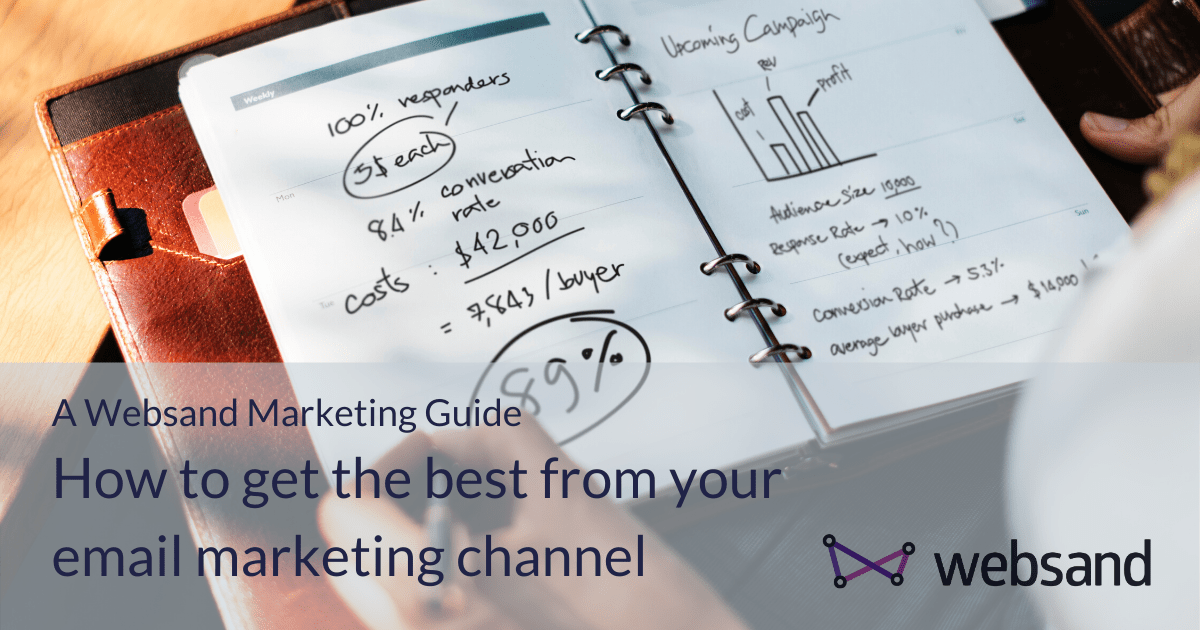How to get the best from your email marketing campaigns
As more and more clients are using Websand to power their email marketing activity, we are dealing with a lot of questions about how they can get the best from their investment in Websand – and email marketing in general.
It’s no longer as simple as import some data, write a message and click send. It’s more scientific than that. So I thought it would be a good idea to document our thoughts, some top line information on the basics to help you get the best from your email marketing.
In this blog post we share some tips and suggestions on
How to manage your subscriber data – how to select your audience
Tips to make sure your email marketing is delivered – the importance of inbox reputation
What to look for in Email measurement – benchmarking and the bigger picture
And, how to manage your email marketing reputation. Yes, that’s a thing.
Pick out what you need and please let us know which bits help you the most by leaving a comment at the end of this post.
Selecting your email marketing audience
The Websand platform was built to make it easy to select and segment your audience for your email marketing campaigns.
Be that a normal newsletter, a message to a specific group of people or to create some more sophisticated data driven marketing targeted at individuals based on customer behaviour such as time since last spend, customer lifetime value levels, cross-selling, or up selling processes.
Don’t carpet bomb.
To get great results, you need to be match your marketing message to the audience. Sending to everyone is one way of addressing that issue.
If you are sending to everyone, then you are increasing the chances of an adverse reaction from those who the message is not relevant, and potentially ‘turn off’ future customers.
That isn’t the reaction you want. You want smiley faces from the audience, not sad or annoyed faces.
If you are still adamant to send to everyone, consider the story of the boy who cried wolf. When the wolf finally arrived, the boy was sending the same message to the same people, but no one was listening.
Match your message and your audience
For some generic marketing messages – company based marketing – it’s relevant to all customers, and all prospects, so it’s ok to send it to everyone.
But where you have specific messages that appeal to specific people, then make sure you apply customer segmentation and target that message to that group of people.
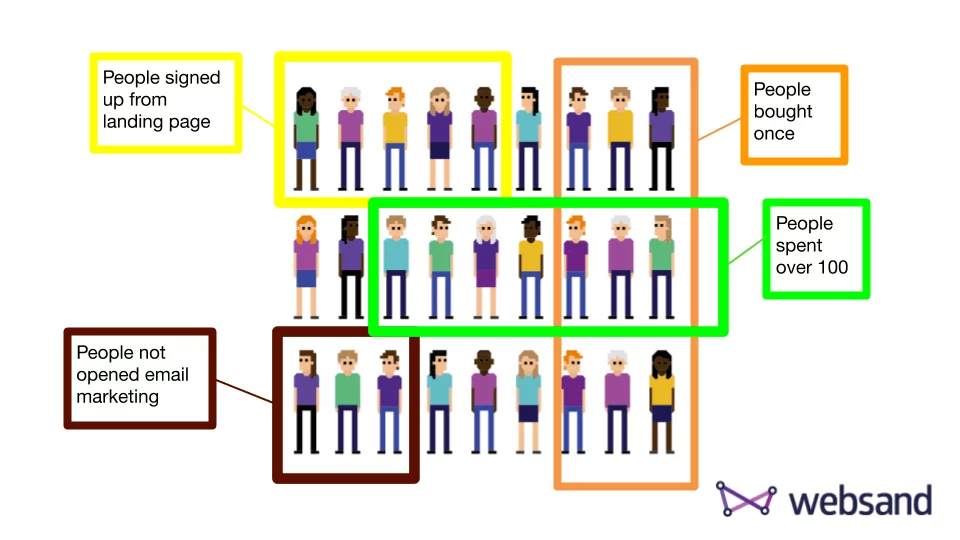
You’ll get a much better response. Promise.
Delivering the message – Managing your inbox reputation
When you send an email message, it needs to be accepted by the addressees inbox.
These inboxes are managed. To keep the addressee safe from unsolicited messages and emails from senders that are deemed ‘untrustworthy’
I like to think of these controls as ‘security’ or ‘bouncers’ for your inbox.
If they don’t like the look of your email, it is not coming in (to your inbox).
The managers of your inboxes are your email providers, Gmail, Hotmail (now live), Yahoo, AOL, Sky, BT.
You need to keep them happy to make sure your email marketing is delivered.
The easiest way to do that is by sending from a trusted IP address, managing your bounce rates and keeping your content targeted (to avoid SPAM alerts from your audience).
A note on mail servers
Especially if you are using your own mail servers, where your management of the key metrics can be problematic and reputation management can also be an issue.
We’ve found that when we’ve moved clients from their own mail server to Websand, we’ve increased deliverability, improve marketing tracking and that’s resulted in better responses and increased sales.
Reviewing what works within your email marketing campaigns
You’ve segmented your email list, created your amazing email marketing message. All personalised and targeted to your audience. Now it’s time to look at the results.
Email marketing metrics
Here’s a screenshot of a rolling 30 day report of email performance. It features the same typical email marketing metrics available from any email marketing system.
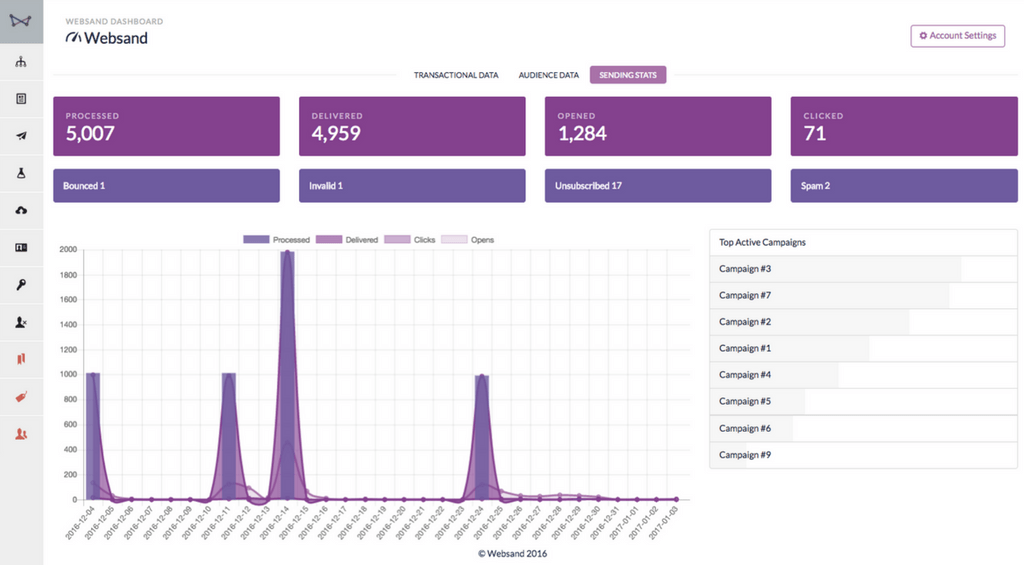
What these email marketing terms really mean are in CAPS.
How many people received the campaign – DELIVERABILITY
Who opened the campaign – RELEVANCE
How many people clicked the message – RELEVANCE
What had the most clicks, and how many people clicked on what – INTEREST
How many people unsubscribed – NOT INTERESTED
What number of emails are now unreachable (bounces, invalid, SPAM) – REPUTATION MANAGEMENT INDICATORS.
Benchmarking your email performance
The results from the big three key measurements – delivered, open and click are then typically reviewed against established ‘benchmarks’.
The benchmarks can be either ‘industry averages’, or as simple as performance against the last message that was sent.
Email Deliverability
This should be at least 98%. Any lower and you’ve potentially got a problem with your data and this will lead to ‘inbox reputation’ issues.
Campaign Open Rates
The overall average open rate – people that have opened a campaign – is 21% (source: Mailchimp). This fluctuates by sector, but as a rule, anything over 20% is regarded as ‘decent’.
Email Click through rates
A few points of note on this, as click performance is dependant on many different factors. Your business, the objective of the email, and your audience.
- If you don’t include hyperlinks in your email marketing you will not report any clicks.
- In most part click throughs on your email will be low, anything above 2% is decent.
- Type of click is important. If you are selling an email exclusive deal and the only way to reach the landing page is via a click on the email – then obviously the number of clicks will impact the overall performance of the campaign.
In my opinion more and more people don’t want to click as they ‘know’ they are being tracked.
However, my feeling is that it doesn’t necessarily mean that they aren’t performing the behaviour that you are looking to encourage – visit your website and buy from you. We are testing this.
Open and Click are “Relevance Indicators”
Open and Click rates are held up as the biggest ratings of email performance. When we are asked ‘what should my open rate be?’ I usually counter with ‘what do you want to achieve?’
My point is that an open rates and click rates are not the key measurements of success they are indicators.
If you want to sell 100 items from Campaign Y then I’d say the overall measurement is whether or not you sell 100 items, rather than if the open rate was 80%.
Obviously the two are linked, but it’s selling the items that a more important that the open rate. I’d say open rate is a ‘relevance indicator’. If the audience isn’t interested then they won’t open or click.
Measuring by campaign vs measuring by customer
However, the performance of your email marketing activity is usually reviewed in splendid isolation.
The big challenge is that these results can be misleading in relation to the bigger picture and your marketing strategy as a whole.
Here is a real life example…
A client was using a product focused approach to marketing. However, the product focus was applied at the message rather than the audience.
As a stage one, we continued this approach to help build up metrics on the audience. Who were engaged, who were not.
Stage two, was to link the marketing behaviour and the spend activity together (in Websand we can do this easily as we track both)
Results from stage one (names and references have been replaced – a full case study on this will follow)
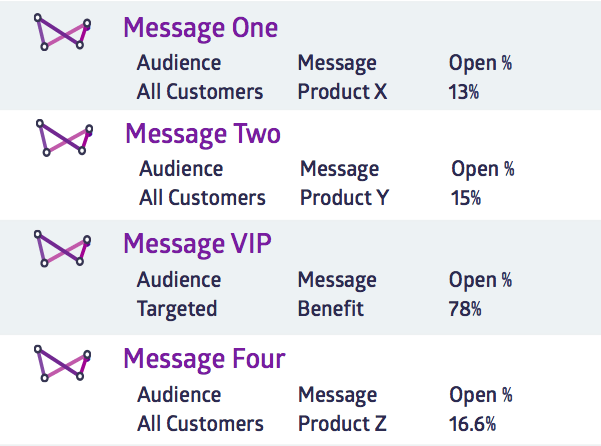
For customer engagement overall. If the open by campaign is reviewed over the period then the maximum engagement is 16%, However, if we look at the open rate across the entire audience for the selected period, then it’s a different picture, an overall open rate of over 30%.
As you’ll notice, the VIP responses are by far the most impressive, which proves the more targeted – the higher the engagement.
Key learnings
Looking at engagement by individual message does not give the overall picture of marketing performance.
Targeted messages resulted in a 4x increase in engagement.
Given that the whole audience was marketed too and the products offered were significantly different it makes sense that some messages appealed to some, some to others.
However, we now have indicators of who is interested in each offering, and who has not shown an interest. We also know which customers were engaged over the period and who was not.
We’ve taken this experience and are now reviewing them in Websand against sales activity. This helps us to drive further engagement and help ecommerce stores adopt a data driven marketing approach to their email marketing.
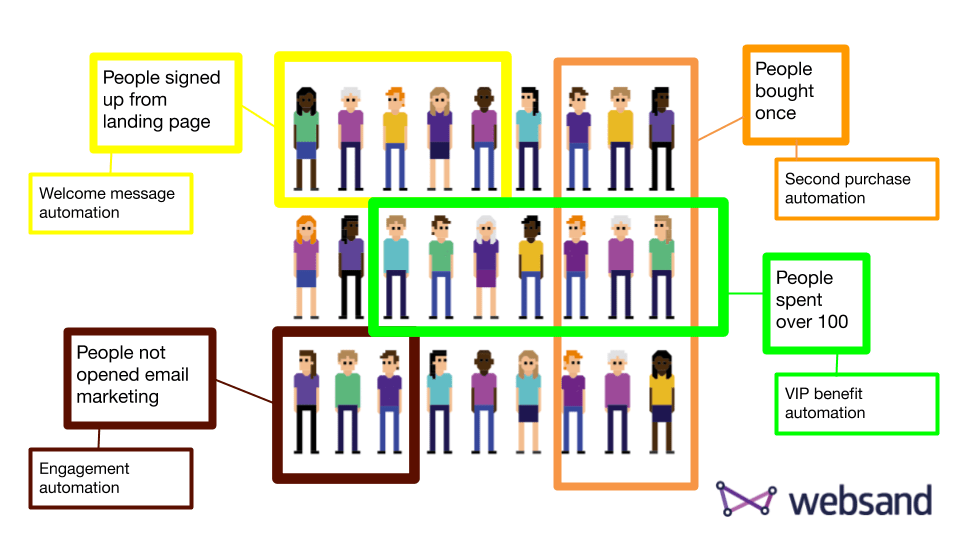
Here’s a chart to show the typical outcomes you can expect depending on your approach to email marketing. For other information check out this blog post about email marketing benchmarks.
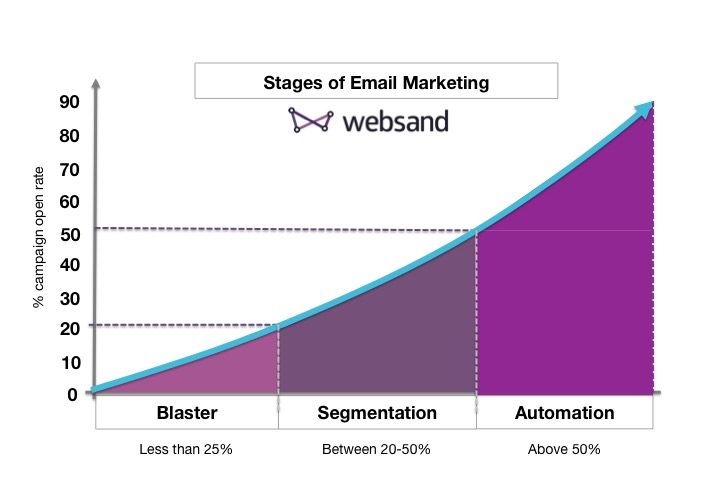
Managing your email marketing fall out
Deliverability can be a hidden issue in the performance of your email marketing.
Your ‘inbox’ reputation is linked to the ip address that you send your email marketing from. If your ‘inbox’ is new, then you will need to warm it up, and prove to the ‘big email managers’ – Gmail, Hotmail, AOL, etc, that you can be trusted.
If you don’t manage your ‘inbox’ reputation then you can get into a bit of bother.
Here are some thoughts to help you address that.
Unsubscribes
I’ve written about my views on unsubscribe before. I think it’s something to be embraced and if people want out, let them out. As my father would say “The doors are there to keep people out, not keep people in”.
Don’t fear the unsubscribe, and don’t get upset. It’s ok for people to opt-out. It means you are marketing to those people that are interested, and helps with your GDPR compliance too.
Bounces – how clean is your data?
Keep an eye on these. Your bounce rate is increasingly important to manage your ‘inbox’ reputation.
If you are trying to send messages to emails that don’t exist or can’t receive them, then this can damage your ‘inbox’ reputation. A bounce will let you know which emails don’t reach the addressee.
A bounce is a ‘return to sender’ message, and it usually tells you why. Two types of bounces exist. A hard bounce and a soft bounce.
What’s a Hard Bounce?
A hard bounce is usually because the recipient’s address is invalid. A hard bounce might occur because the domain name doesn’t exist or because the recipient is unknown.
What’s a Soft Bounce
A soft bounce is described by Campaign Monitor as
Your email campaign got as far as the receiving mail server, meaning the email address was recognized, but the message bounced back undelivered instead of reaching the recipient’s inbox
So a soft bounce is where an email is already full? The addressee has left? or the ‘bouncer’ described earlier is not allowing your email to enter the inbox and has swatted away that email you’ve spent ages designing.
The soft bounce reporting will help you to understand where the problem lies. But if a spike in soft bounces could mean that your ‘inbox reputation’ has become an issue.
Managing your bounces
If an email address has a bounce, then remove them from your email marketing. In most cases for ESP’s, this will be handled automatically. The bounce message you will receive will help you to understand the issue with the email.
Based on that message you can decide the best way forward.
Bounce note for e-commerce (especially Magento users)
If you are using Magento and enter dummy email addresses as part of the ordering process, then make sure these are removed from your email marketing. The bounce on these could be considerable and that will impact your ‘inbox reputation’.
SPAM reports – not good news.
If you are sending relevant targeted marketing to an audience that agrees the marketing message you are sending are of value, then you won’t get these.
Of course, very few things are perfect and on occasion you might get a few Spam reports recorded. That’s ok.
If you get these regularly, then your ‘inbox’ reputation could be at risk.
If that is the case, consider a change in how you are using email marketing. Be more targeted in your approach. Make your messages shorter or send your email marketing with less frequency.
This is important. So keep an eye on this.
Make your email marketing the best it can be…
Email marketing seems like a simple process, but it can be a lot more complicated than it first seems. Hopefully this post has been useful to help you understand more about the process and how you can get your email marketing in top condition. Or as my daughter would say… living its best life.
If you’d like some more help on how you can improve your email marketing further, we’d love to help you. Please book a call by clicking here.
It’s time to start getting more from your email marketing
Sign up for a free Websand demo and let’s show you how to get the best from your email marketing.
